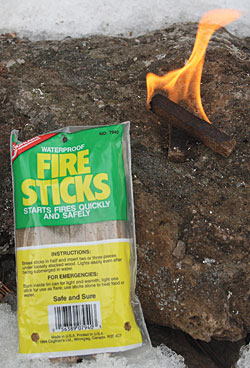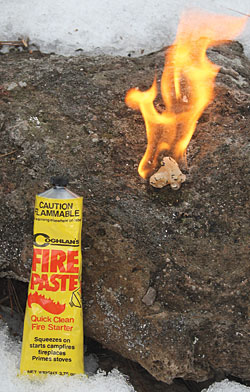November 08, 2010
A good fire starter could save your life, and these are some of the best.
By John Solomon

Advertisement
Here, Jeff Waring and Larry D. Jones dry off after a thunderstorm in New Mexico's Gila Wilderness. Pitch wood did the trick. |
Advertisement
ATTENDEES AT MY survival workshops frequently ask, "What is the best fire starter?" My answer is that a number of excellent choices fit a variety of budgets and preferences. Regardless of whether you carry store-bought, homemade, or natural fire starter (tinder), the starter must do its job. This means the tinder should light easily, burn with a strong flame, and, most importantly, burn long enough to set your kindling ablaze, even in damp conditions. I've tested a few of the more common fire starters available in sporting goods stores, as well as a homemade one and a couple often found in the woods. Here are my findings:
WetFire by Ultimate Survival Technologies
(www.ultimatesurvival.com)
This is the best store-bought tinder I've used for a few reasons: It lights well with a flame or a spark from a metal match, it is small and lightweight, and it burns long. If you are lighting it with a metal match (sparks), you must crush or shave it first. You can quickly and easily crush it by pinching it with your fingers. It burns very cleanly. I've used this product to heat canteen cups of water (one cube burning by itself), giving it some versatility in your kit.
Cost: Average is $10 for a package of eight cubes
Flammability: Lights easily with spark or flame; needs to be prepped for sparks
Strength: Flame peaked at 6" and averaged 3"
Duration: Averaged 3.5-4.5 minutes
"Fire Sticks" by Coghlan's
(www.coghlans.com)
This cost-effective fire starter produces a strong, long-lasting flame. Several companies make similar products, and essentially they are all the same material you would find in a fireplace "fake log." In fact, you can buy a fake log and carve pieces off for even more cost savings -- and one log will last you for years. The material is impervious to weather and burns well, but to light it with a spark you must prep it by cutting and shaving.

WetFire |
Cost: Average is $6 for a package of 10 sticks
Flammability: Takes several seconds to light with flame; needs to be prepped for sparks
Strength: Flame peaked at 10"-11" and averaged 6"
Duration: Averaged 8 minutes
"Fire Paste" by Coghlan's
(www.coghlans.com)
I know of a few people who carry this for emergencies, and it does burn well. It's simple to use -- just squirt out a gob and light it. However, if a tube breaks in your pack, the paste will ruin the nylon and likely whatever else it smears on. As a petroleum product, it produces a hot flame with black smoke.
Cost: Average is $8 for one tube
Flammability: Lights easily with spark or flame
Strength: Flame peaked at 10" and averaged 5" (tablespoon size sample)
Duration: Tablespoon size averaged 5.5 minutes

Fire Sticks |
Magnesium Bar
This is a common fire starter in student survival kits. The idea is to shave off a pile of magnesium flakes and then to light them with sparks from the imbedded metal match. Shaving the magnesium takes time, proves difficult if cold weather impairs your motor skills, and rarely gives you a neat pile of shavings -- it took me three minutes to shave a tablespoon-size pile. A serrated blade yields thicker and longer scrapings than does a smooth blade, thus creating a larger flame when lit. The shavings burn hot but very fast. An alternative is to scrape shavings into substantial tinder like dead grass or leaves, using the magnesium as an accelerant rather than a stand-alone fire starter.
Cost: Average is $6 for one bar
Flammability: Piles of shavings often burn inconsistently
Strength: Flame averaged 3"-4" (tablespoon-size sample)
Duration: Tablespoon size averaged 10 seconds
Cotton balls saturated with petroleum jelly (homemade)
This is the best tinder I've used, period. It takes a spark easily, requires minimal prep time, produces a strong flame, and costs almost nothing. To light and burn well, the cotton ball must be pulled apart several times to allow oxygen into the fibers before you ignite it. I always carry a dozen in my kit. Given the performance of one cotton ball, two or three together produce a blaze.
Cost: Averages pennies per fire starter
Flammability: Lights easily with spark or flame
Strength: Flame peaked at 6" and averaged 3"-4" (one cotton ball)
Duration: One cotton ball averaged 4.5-5 minutes

Fire Paste |
Pitch wood (natural)
You must prepare this tinder for lighting with either sparks or flame by scraping off a handful of shavings, although small kindling-sized pieces of pitch will light after being exposed to a flame for a few seconds. If you find pitch wood, you've found excellent tinder. Use it to start your fire, and break down the rest for kindling and fuel -- but save some to put in your pack as emergency fire starter later.
Cost: N/A
Flammability: Lights easily with spark or flame; needs to be prepped for sparks
Strength: Flame peaked at 6" and averaged 3" (two tablespoons of shavings)
Duration: Two tablespoons of shavings averaged 2.5-3 minutes
Birch bark (natural)
Most common in the East and across Canada and Alaska but also a possibility in the West, birch bark is a thick, fibrous tinder that lights easily with a flame. It does require some prep for lighting with sparks. To prepare the bark, bundle a few strips in your hands and rub back and forth to break the bark down into small, stringy fibers.
Cost: N/A
Flammability: Lights easily with flame; needs to be prepped for sparks
Strength: Flame averaged 6"-8" (one strip about 8"x 2")
Duration: One strip 8"x 2" averaged 45 second

